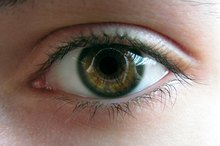What does fact checked mean?
At Healthfully, we strive to deliver objective content that is accurate and up-to-date. Our team periodically reviews articles in order to ensure content quality. The sources cited below consist of evidence from peer-reviewed journals, prominent medical organizations, academic associations, and government data.
The information contained on this site is for informational purposes only, and should not be used as a substitute for the advice of a professional health care provider. Please check with the appropriate physician regarding health questions and concerns. Although we strive to deliver accurate and up-to-date information, no guarantee to that effect is made.
What Are the Causes of Involuntary Eye Movement?
Involuntary eye movement, a condition doctors refer to as nystagmus, causes the eyes to move up and down or side to side. Some people experience circular eye movement as well. People with nystagmus might not realize their eyes move unless the eyes move in extreme motions. Knowing some of the causes of nystagmus could help determine the reason the condition appeared since nystagmus can result from a number of conditions.
If you are experiencing serious medical symptoms, seek emergency treatment immediately.
Congenital Cataracts
Some children have involuntary eye movement at birth. Congenital cataracts typically cause this type of eye movement, particularly if the cataract has a significant effect on vision. Cataracts result when the natural lens in the eye turns cloudy, and congenital cataracts appear at birth or very early in childhood. Other symptoms of congenital cataract may include a white appearance to the pupil and a lack of visual interest, explains the University of Maryland Medical Center. An eye doctor will monitor the cataract and vision. Many children do not require early treatment of the cataract, but they might need an eyeglass prescription for the best possible vision. If the cataracts affect vision, an eye doctor could recommend surgical removal of the cataract.
- Some children have involuntary eye movement at birth.
- Cataracts result when the natural lens in the eye turns cloudy, and congenital cataracts appear at birth or very early in childhood.
Systemic Conditions
Abnormal Eye and Head Movements in Children
Learn More
Certain systemic diseases or conditions, such as albinism, for example, may cause nystagmus. Albinism causes a number of eye problems in addition to involuntary eye movement, such as light sensitivity, eye misalignment and extreme refractive errors, states MayoClinic.com. Albinism results from a genetic condition that prevents the body from making pigment, causing a person to have pale skin. In addition to affecting eye motility, the lack of pigment will also affect the color of the eyes. The iris will have an almost transparent appearance, causing eye color to seem red.
Other systemic conditions and diseases that can result in nystagmus may involve inner ear conditions, such as Meniere’s disease, or toxicity from drugs, alcohol or prescription medications. If a systemic condition has available treatments, controlling or resolving the medical condition might reduce episodes of involuntary eye movement. Some conditions, such as albinism, which do not have treatments, may require surgery on the muscles of the eye to reduce the occurrence.
- Certain systemic diseases or conditions, such as albinism, for example, may cause nystagmus.
- Some conditions, such as albinism, which do not have treatments, may require surgery on the muscles of the eye to reduce the occurrence.
Neurological
Neurological disorders can cause nystagmus. For example, conditions such as a brain tumor or multiple sclerosis could cause nystagmus, explains MedlinePlus 2. In most neurological conditions, the involuntary eye movements will not improve but may gradually worsen with the disorder. Multiple sclerosis is one such progressive disease that does not have a cure. The instances of involuntary eye movements will often increase as the disease worsens and, in most cases, surgical treatment of the muscles will not have a long-term effect. Treatment and resolution of brain tumors that affect eye movement may still leave residual neurological problems. Some patients may experience complete return of normal eye movements, but others might continue to have involuntary eye movements.
- Neurological disorders can cause nystagmus.
- In most neurological conditions, the involuntary eye movements will not improve but may gradually worsen with the disorder.
Related Articles
References
- Mayo Clinic: Albinism
- MedlinePlus: Nystagmus
- Parashkev Nachev, Geoff E. Rose, David H. Verity, Sanjay G. Manohar, Kelly MacKenzie, Gill Adams, Maria Theodorou, Quentin A. Pankhurst, Christopher Kennard. Magnetic Oculomotor Prosthetics for Acquired Nystagmus. Ophthalmology, 2017; DOI: 10.1016/j.ophtha.2017.05.028.
- Boyd, Kierstan. "What Is Nystagmus?" American Academy of Ophthalmology (AAO). 2017.
- Powell, Selina. "Magnetic implants control involuntary eye movements or dancing eyes." Optometry Today (OT). 2017.
Writer Bio
Kate Beck started writing for online publications in 2005. She worked as a certified ophthalmic technician for 10 years before returning to school to earn a Masters of Fine Arts degree in writing. Beck is currently putting the finishing touches on a novel.








